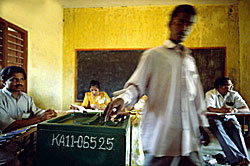 |
NEW DELHI?India is officially in election mode. Speculation is rife about the possible results as alliances are re-engineered.
As India's Election Commission prepares for what is the most ambitious democratic exercise in the world, the best and worst of politics is on display.
No one quite knows what to expect from the polls. With the rise of regional parties and the absence of a single overarching issue, the final outcome will actually be an aggregation of results in 28 states. The recent delimitation of constituencies, with an increase in urban seats, has added to the uncertainty.
But here is the big picture: the Lok Sabha will continue to be fragmented. As the BJP's prime ministerial candidate, the venom spewing Ram Yatri turned moderate. L K Advani said that what will matter most is the "alliance index".
Neither of the big fronts, the Congress led UPA in its present shape or the BJP led NDA or the disparate 'third front' consisting of left and a few regional parties, are expected to have the numbers on their own. So, it will boil down to the post poll partnerships when loyalties will swing.
The conventional wisdom here is that the UPA has an edge. The recent state assembly defeats have left the BJP demoralised. The government's deft handling of the Mumbai aftermath with a mix of belligerence and restraint has deprived the BJP of the one issue they could have made their own: national security. Hindutva is not selling anymore. The UPA's social schemes, particularly the employment guarantee act, may also swing the rural votes in
its favour.
The problem for the UPA is that it is not looking good in the four states that matter the most. DMK is weak in Tamil Nadu (the state has 39 seats). The Congress- Samajwadi Party alliance has not shaped up yet in UP (80 seats). And in Bihar (40 seats), even with a Congress-Laloo-Ram Vilas Paswan alliance, Nitish Kumar has the momentum for having delivered on development. And Congress already peaked in Andhra Pradesh (42 seats) last time.
That leaves the polity in the hands of two mercurial ladies: Mayawati in Uttar Pradesh and Jayalalitha in Tamiul Nadu. Both are closer to the third front at present but the absence of any ideological character allows them to switch sides whenever they want. And the third front is not looking too good anyway with the left suffering in both West Bengal and Kerala?it will be lucky if it can keep even 35-40 seats, a massive dip from its 60 plus seats last time.
These permutations throw open all kinds of possibilities. A Manmohan Singh led UPA again but with newer allies; a non-Manmohan Singh led UPA with left support (left will be averse to him after the nuclear deal acrimony); a third front government backed by Congress (led by a regional satrap like Sharad Pawar or Mayawati); or in case things change in the next few weeks, a BJP led government. Whatever the outcome, there is a possibility of an inherently unstable arrangement at the top.
What does all this mean for Nepal? Whoever comes to power, including the BJP, the engagement with the Maoists will continue. BJP spokesperson Ravi Shankar Prasad told Nepali Times this week: "We respect the democratic aspirations of the Nepali people but will oppose any attempt to disrupt the social, cultural, ethnic, religious and spiritual ties between the two countries." Prasad was present at Pushpa Kamal Dahal's meeting with BJP president Rajnath Singh last September. Dahal also has good relations with Sharad Yadav, who is now the convenor of the NDA.
But there will be a review of policy, and positions may harden on Nepal. That has more to do with the domestic situation in Kathmandu. The Indians are worried about Maoist consolidation, and the China card which many see as having gone beyond just balancing India.
"We factor in a bit of balancing anyway. But if it is used to help the Chinese establish their presence near the border and cut down our role, there will be a reaction. We may also be forced to review the open border relationship," a top official told us.
Some others in the policy establishment however are more sanguine and say the Chinese are more worried about western-backed Tibet protests, not India.



